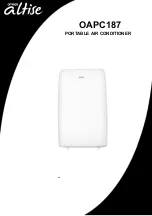
OTHER TIPS
18
preventing the ingress of flammable atmospheres. Replacement parts shall be in accordance with the
manufacturer's specifications.
NOTE: The use of silicon sealant may inhibit the effectiveness of some types of leak detection equipment.
Intrinsically safe components do not have to be isolated prior to working on them.
8.Repair to intrinsically safe components
Do not apply any permanent inductive or capacitance loads to the circuit without ensuring that this will not
exceed the permissible voltage and current permitted for the equipment in use.
Intrinsically safe components are the only types that can be worked on while live in the presence of a flammable
atmosphere. The test apparatus shall be at the correct rating.
Replace components only with parts specified by the manufacturer. Other parts may result in the ignition of
refrigerant in the atmosphere from a leak.
9.Cabling
Check that cabling will not be subject to wear, corrosion, excessive pressure, vibration, sharp edges or any
other adverse environmental effects. The check shall also take into account the effects of aging or continual
vibration from sources such as compressors or fans.
10.Detection of flammable refrigerants
Under no circumstances shall potential sources of ignition be used in the searching for or detection of
refrigerant leaks. A halide torch (or any other detector using a naked flame) shall not be used.
11.Leak detection methods
The following leak detection methods are deemed acceptable for systems containing flammable refrigerants.
Electronic leak detectors shall be used to detect flammable refrigerants, but the sensitivity may not be adequate,
or may need re-calibration. (Detection equipment shall be calibrated in a refrigerant-free area.) Ensure that the
detector is not a potential source of ignition and is suitable for the refrigerant used. Leak detection equipment
shall be set at a percentage of the LFL of the refrigerant and shall be calibrated to the refrigerant employed and
the appropriate percentage of gas (25 % maximum) is confirmed.
Leak detection fluids are suitable for use with most refrigerants but the use of detergents containing
chlorine shall be avoided as the chlorine may react with the refrigerant and corrode the copper pipe-work.
If a leak is suspected, all naked flames shall be removed/ extinguished.
If a leakage of refrigerant is found which requires brazing, all of the refrigerant shall be recovered from the
system, or isolated (by means of shut off valves) in a part of the system remote from the leak. Oxygen free
nitrogen (OFN) shall then be purged through the system both before and during the brazing process.
12.Removal and evacuation
When breaking into the refrigerant circuit to make repairs or for any other purpose conventional procedures
shall be used. However, it is important that best practice is followed since flammability is a consideration. The
following procedure shall be adhered to:
Remove refrigerant;
Purge the circuit with inert gas;
Evacuate;
Purge again with inert gas;
Open the circuit by cutting or brazing.
Summary of Contents for CP012IU-PD
Page 2: ......
Page 112: ...comfee by Midea ECO FRIENDLY 10...
Page 113: ...2 3 3 4 4 5 6 7 9 9 12 13 14 15 A B A B...
Page 114: ...A B C D...
Page 115: ...17 C 62 F 35 C 95 F 13 C 55 F 35 C 95 F 5 C 41 F 30 C 86 F 30 C 86 F 1 Phillips 2 30...
Page 116: ...3 4...
Page 117: ...B 1 B 1 A 1 4 1 4 1 1...
Page 118: ...1 2 3 4 5 6 7 8 9 10 11 12 13 14 15...
Page 119: ...1 2 SLEEP 3 FAN ION ION 3 3 4 1 C 2 F 17 C 62 F 30 C 86 F 0 24 3...
Page 123: ...30 5 6 7 7a 5 7a 67 5 2 22 123 4 04 6 7 67 5 2 22 123 4 04...
Page 124: ...1 A 8 B A 9 2 B 67 5 26 5 B 9 3 10 4 5 11 8 9 10 A B B 26 5 48 67 5 123...
Page 125: ...1 A 12 2 67 5 13 3 14 4 5 15 12 A 26 5 48 67 5 123 13 14 15...
Page 126: ...1 B 16 17 2 18 A 1 A 4 19 2 20 16 17 18 A 19 20...
Page 127: ...5 8 3 4 21 22 8 P1 23 P1 21 22 23...
Page 128: ...1 2 3 4 1 24 25 24 40 C 104 F 2 3 23 24 23 24 25...
Page 129: ...1 P1 2 4 5 6 70 C 158 F...
Page 132: ......
















































